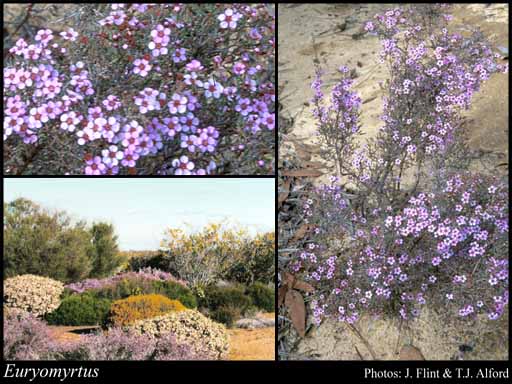- Reference
- Linnaea 17 p239 (1843)
- Name Status
- Current

Scientific Description
Family Myrtaceae.
Habit and leaf form. Shrubs; evergreen; bearing essential oils. Plants with neither basal nor terminal concentrations of leaves; to 0.1–0.9 m high. Leptocaul. Helophytic to xerophytic. Leaves small to large; opposite; ‘herbaceous’, or leathery; petiolate, or subsessile to sessile (in E. maidenii); gland-dotted; aromatic; edgewise to the stem, or with ‘normal’ orientation; simple; epulvinate. Leaf blades dorsiventral, or isobilateral, or centric; entire; flat, or rolled (the leaves of E. recurva tightly involute and appearing 2-channelled); linear, or lanceolate, or oblong, or ovate; linear, or ovate, or obovate, or oblong, or elliptic; pinnately veined, or parallel-veined, or one-veined; cross-venulate, or without cross-venules. Mature leaf blades adaxially glabrous, or scabrous; abaxially glabrous, or scabrous. Leaves without stipules; without a persistent basal meristem. Leaf anatomy. Hairs absent. Stem anatomy. Secondary thickening developing from a conventional cambial ring.
Reproductive type, pollination. Fertile flowers hermaphrodite. Unisexual flowers absent. Plants hermaphrodite. Entomophilous, or ornithophilous. Pollination mechanism unspecialized.
Inflorescence and flower features. Flowers solitary, or aggregated in ‘inflorescences’. Inflorescences simple, or compound. The terminal inflorescence unit cymose. Inflorescences terminal, or axillary; of brachyblasts bearing 2–4 monads, except in E. maidenii which has only axillary monads. Flowers (bi) bracteolate; small to large; regular; 5 merous; cyclic. Free hypanthium present (petals ‘inserted on the calyx’); obconic (or hemispherical to semi-ellipsoidal or barrel-shaped); fused to the lower 1/3 – 3/4 of the ovary. Hypogynous disk present. Perianth with distinct calyx and corolla; 10; 2 -whorled; isomerous. Calyx present; 5; 1 -whorled; polysepalous, or gamosepalous (depending on interpretation). Calyx segments entire. Calyx erect, or spreading; imbricate, or valvate; regular. Calyx lobes elliptic, or triangular, or orbicular. Corolla present; 5; 1 -whorled; polypetalous; imbricate; regular; plain, or with contrasting markings; white, or white and red, or white and pink, or white and purple. Petals elliptic, or oblong, or orbicular. Androecial members definite in number, or indefinite in number. Androecium 3–29. Androecial members branched, or unbranched. Androecial sequence determinable, or not determinable. Androecial members if ‘many’, maturing centripetally; free of the perianth; all equal (when 5 or less stamens), or markedly unequal (the antepetalous stamens longest); free of one another; when ‘definite‘, 2 -whorled. Stamens 3–29; becoming exserted, or remaining included; reduced in number relative to the adjacent perianth to polystemonous; alternisepalous, or alternisepalous and oppositisepalous; all opposite the corolla members, or both opposite and alternating with the corolla members; erect in bud, or inflexed in bud. Filaments not geniculate; filiform (though sometimes slightly flattened near the base). Anthers dorsifixed; versatile; dehiscing via longitudinal slits; introrse; tetrasporangiate; appendaged, or unappendaged. Gynoecium 3–4 carpelled. The pistil 3(–4) celled. Gynoecium syncarpous; eu-syncarpous; inferior, or partly inferior. Ovary plurilocular; 3(–4) locular. Epigynous disk present, or absent. Gynoecium stylate. Styles 1; from a depression at the top of the ovary; apical. Stigmas 1; capitate. Placentation axile. Ovulodes absent. Ovules 2–6 per locule; ascending; non-arillate; anatropous.
Fruit and seed features. Fruit non-fleshy; dehiscent; a capsule (opening widely with prominent valves (except in E. inflata). Seeds reniform; non-endospermic; arillate, or non-arillate (sometimes, in E. leptospermoides). Cotyledons 2. Embryo filling the seed, the radicle massive.
Geography, cytology, number of species. Native of Australia. Endemic to Australia. Australian states and territories: Western Australia, South Australia, New South Wales, Victoria, Australian Capital Territory, and Tasmania. South-West Botanical Province.
Keys
A Key to Western Australian Species in the Chamelaucieae Tribe of Myrtaceae
B.L. Rye, M.D. Barrett, T.D. Macfarlane, N.S. Lander, M.E. Trudgen, N.G. Marchant, K.R. Thiele